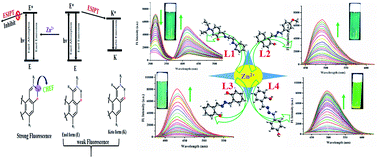Subtle structural variation in azine/imine derivatives controls Zn2+ sensitivity: ESIPT-CHEF combination for nano-molar detection of Zn2+ with DFT support†
Abstract
Excited-state intra-molecular proton transfer (ESIPT)-active imine and azine derivatives, structurally characterised by XRD, and denoted L1, L2, L3 and L4, possess weak fluorescence. The interaction of these probes with Zn2+ turns ON the fluorescence to allow its nano-molar detection. Among the four ESIPT-active molecules, L2, L3 and L4 are bis-imine derivatives while L1 is a mono-imine derivative. Among the three bis-imine derivatives, one is symmetric (L3) while L2 and L4 are unsymmetrical. The lowest detection limits (DL) of L1, L2, L3 and L4 for Zn2+ are 32.66 nM, 36.16 nM, 15.20 nM and 33.50 nM respectively. All the probes bind Zn2+ (105 M−1 order) strongly. Computational studies explore the orbital level interactions responsible for the associated photo-physical processes.



 Please wait while we load your content...
Please wait while we load your content...